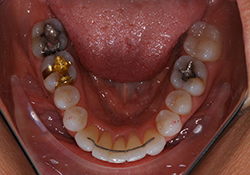Bonded (Lingual) Retainer
What the Appliance Does
 Depending on the amount of crowding or rotation of the upper and lower front teeth, Dr. Komoroski may have prescribed a “bonded” or fixed retainer in order to serve as a full time retainer. The appliance consists of a wire or gold chain that is bonded to the inside surface of the teeth. Typically the resin used to bond the wire to the teeth can last 3-7 years, depending on how careful the patient is with functioning with the retainer.
Depending on the amount of crowding or rotation of the upper and lower front teeth, Dr. Komoroski may have prescribed a “bonded” or fixed retainer in order to serve as a full time retainer. The appliance consists of a wire or gold chain that is bonded to the inside surface of the teeth. Typically the resin used to bond the wire to the teeth can last 3-7 years, depending on how careful the patient is with functioning with the retainer.
Cleaning the Retainer
- A floss threader is needed to lace floss underneath the wire. Thread the needle of the floss threader with dental floss or tape, pass the floss threader in between the teeth that are connected with the bonded retainer. Pull the floss half way through. Use a circular or “c” type motion to rub the floss up and down the necks of the teeth. Pull floss through the contact, do not lift the floss up between the teeth.
- A Waterpik™ is a useful adjunct in keeping the retainer clean. Use this cleaning aid on its lowest setting.
- There will be a certain path or direction that the floss threader will follow to move through the teeth. If the floss threader does not easily pass, take the floss threader out and try again.
- When the braces are first removed, the gum tissue is slightly inflamed. By stimulating the gum through flossing, the tissue will become firm and flossing should be easier.
Things to Watch For
- Bonded lingual retainers placed on the upper front teeth require that you do not bite directly into hard or crunchy foods. Typically, when patients function directly on the bonded teeth, the resin (glue) will eventually break. Bagels, pizza crust and very sticky foods seem to cause failures.
- If the teeth that have the bonded retainer became wet during its placement, sometimes the resin does not bond to the enamel properly and will fail.
- Remind your dental hygienist that you have the bonded retainer and to inspect the wire at each cleaning. A bond failure can occur without the patient being aware that it happened.
- Your family dentist may recommend more frequent cleanings if he/she deem that you need increased help in maintaining the bonded retainer.
- Most patients have not issues with their bonded retainers, while others have frequent failures. Typically, Dr. Komoroski will repair or replace the bonded retainer one time within the first three months. Should two failures occur, additional fees are incurred to repair or replace the bonded lingual retainer. If multiple failures occur no additional bonding will be attempted.
Please note that there are “legacy” costs associated with bonded lingual retainers. The dental resins do not last forever. There is a lifespan for dental resins. How long the bonding will last is variable and dependent on each patient’s individual chewing patterns, cleaning and other factors unique to the patient. One should expect some fees for maintenance associated with the bonded retainer.
